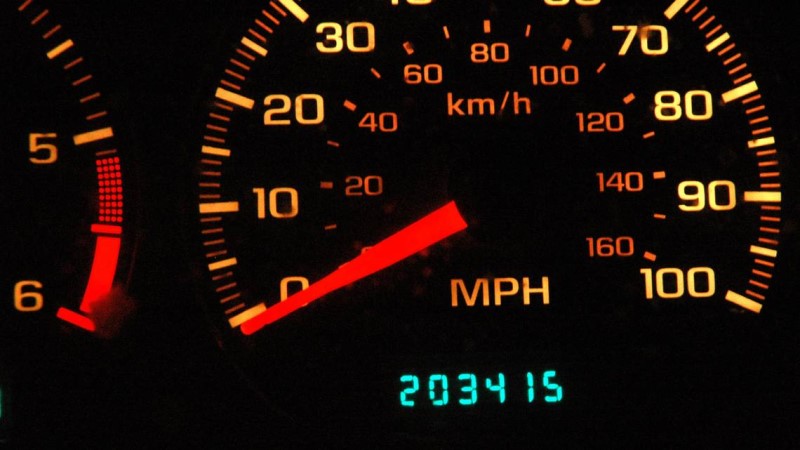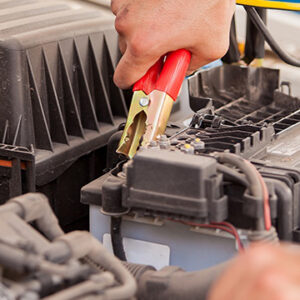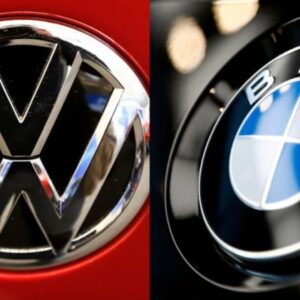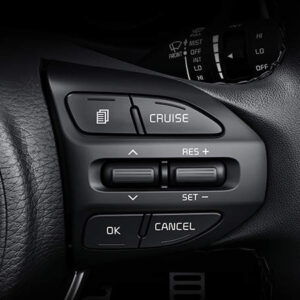What is Odometer? The odometer in car is probably the most unknown and yet most visible component. If you go out and ask any random car owner about the odometer, there are chances that he/she might not be even aware of it. Beneath the steering wheel, on the dashboard, is the odometer which displays the distance a car has run for.
What is Odometer?
An odometer is a device for measuring the distance traveled by a vehicle. The odometer usually lives in the vehicle’s dashboard. “Odometer” derives from two Greek words meaning “path” and “measure.”

An odometer may be digital or mechanical. Each cog on a mechanical odometer represents a digit. The cogs turn in response to the rotation of the wheels via a drive mechanism and cable.
A windowed casing shows only the current mileage of the vehicle and not the mechanical parts. Digital odometers use a computer chip to track mileage, storing data in the engine control module (ECM). The odometer will digitally display the current mileage.
A vehicle may also have a trip meter or trip odometer. Unlike the regular odometer, you can reset the trip odometer at any point. A vehicle may have several trip odometers. Trip meters can be highly beneficial for recording the distance traveled over a specific time, making it easy to determine how many miles per gallon your vehicle gets for each fuel tank.
The resale value of a vehicle is often significantly affected by mileage. The lower the mileage on a car, the higher the resale value. When a seller manually sets an odometer to display a falsely deflated mileage, they commit odometer fraud or “clocking.”
The idea behind clocking is to make it look like the vehicle has traveled less mileage than it actually has. The mileage in cars with a digital odometer is stored in the engine control module, making it more difficult to change the mileage manually.
Mechanics must maintain records of the odometer reading each time they service a vehicle. Authorities instituted this rule to combat odometer fraud. Many car service companies use this information to help buyers detect possible odometer fraud.
How does an odometer work?
Odometers measure the total distance that your vehicle has traveled. They typically work by counting wheel rotations and assuming that the distance traveled is the number of wheel rotations multiplied by the tire’s circumference.
Keep in mind that your odometer will be most accurate when your car or motorcycle is equipped with standard-sized tires that are in good condition and properly inflated.
Mechanical Odometers
Mechanical odometers are turned by a flexible cable made from a tightly wound spring. The cable usually spins inside a protective metal tube with a rubber housing.
On a bicycle, a little wheel rolling against the bike wheel turns the cable, and the gear ratio on the odometer has to be calibrated to the size of this small wheel. On a car, a gear engages the output shaft of the transmission, turning the cable.
The cable snakes its way up to the instrument panel, where it is connected to the input shaft of the odometer.
The Gearing
This odometer uses a series of three worm gears to achieve its 1690:1 gear reduction. The input shaft drives the first worm, which drives a gear. Each full revolution of the worm only turns the gear one tooth. That gear turns another worm, which turns another gear, which turns the last worm and finally the last gear, which is hooked up to the tenth-of-a-mile indicator.
Each indicator has a row of pegs sticking out of one side, and a single set of two pegs on the other side. When the set of two pegs comes around to the white plastic gears, one of the teeth falls in between the pegs and turns with the indicator until the pegs pass. This gear also engages one of the pegs on the next bigger indicator, turning it a tenth of a revolution.

You can now see why, when your odometer “rolls over” a large number of digits (say from 19,999 to 20,000 miles), the “2” at the far left side of the display may not line up perfectly with the rest of the digits. A tiny amount of gear lash in the white helper gears prevents perfect alignment of all the digits. Usually, the display will have to get to 21,000 miles before the digits line up well again.
You can also see that mechanical odometers like this one are rewindable. When you run the car in reverse, the odometer actually can go backwards — it’s just a gear train.
In the movie “Ferris Bueller’s Day Off,” in the scene where they have the car up on blocks with the wheels spinning in reverse — that should’ve worked! In real life, the odometer would’ve turned back. Another trick is to hook the odometer’s cable up to a drill and run it backwards to rewind the miles.
While that does work on older mechanical odometers, it does not work on the new electronic ones, as we will see in the next section…
Computerized Odometers
If you make a trip to the bike shop, you most likely won’t find any cable-driven odometers or speedometers. Instead, you will find bicycle computers. Bicycles with computers like these have a magnet attached to one of the wheels and a pickup attached to the frame.
Once per revolution of the wheel, the magnet passes by the pickup, generating a voltage in the pickup. The computer counts these voltage spikes, or pulses, and uses them to calculate the distance traveled.
If you have ever installed one of these bike computers, you know that you have to program them with the circumference of the wheel. The circumference is the distance traveled when the wheel makes one full revolution. Each time the computer senses a pulse, it adds another wheel circumference to the total distance and updates the digital display.
Many modern cars use a system like this, too. Instead of a magnetic pickup on a wheel, they use a toothed wheel mounted to the output of the transmission and a magnetic sensor that counts the pulses as each tooth of the wheel goes by.
Some cars use a slotted wheel and an optical pickup, like a computer mouse does. Just like on the bicycle, the computer in the car knows how much distance the car travels with each pulse, and uses this to update the odometer reading.
One of the most interesting things about car odometers is how the information is transmitted to the dashboard. Instead of a spinning cable transmitting the distance signal, the distance (along with a lot of other data) is transmitted over a single wire communications bus from the engine control unit (ECU) to the dashboard.
The car is like a local area network with many different devices connected to it.

Many vehicles use a standardized communication protocol, called SAE J1850, to enable all of the different electronics modules to communicate with each other.
The engine control unit counts all of the pulses and keeps track of the overall distance traveled by the car. This means that if someone tries to “roll back” the odometer, the value stored in the ECU will disagree. This value can be read using a diagnostic computer, which all car-dealership service departments have.
Several times per second, the ECU sends out a packet of information consisting of a header and the data. The header is just a number that identifies the packet as a distance reading, and the data is a number corresponding to the distance traveled.
The instrument panel contains another computer that knows to look for this particular packet, and whenever it sees one it updates the odometer with the new value. In cars with digital odometers, the dashboard simply displays the new value. Cars with analog odometers have a small stepper motor that turns the dials on the odometer.
Why is the odometer reading important?
The numbers you read on the odometer show you how many miles the vehicle has travelled. When you look at the odometer, you know how many miles are on that vehicle’s engine, transmission and other vital parts.
This measurement is important to know before you purchase a vehicle since the mileage determines a large part of the car’s value. Vehicles are often priced according to the model year, condition and mileage. The lower the mileage, the higher the resale value typically is.
How to calculate fuel economy with the odometer?
You can use the odometer to figure out the approximate fuel economy of your vehicle. Knowing what the car should be getting, you can determine if the engine isn’t working as it should.
- When your fill-up the gas tank, reset the trip odometer.
- Drive normally until the next time your fill-up.
- At that filling session, write down the number of gallons you added and take note of the trip mileage since the last fill-up. This shows how many miles you drove for that many gallons of gas.
- You can divide the number of miles driven by the number of gallons you put in the tank. For example, if you drove 200 miles on 10 gallons of fuel, the average fuel economy was 20 mpg.
To get the most accurate reading, try to record the mileage for an entire tank of fuel. You can also perform the test several times to see a better average.
For what purpose odometer is used in vehicle?
An odometer for automobiles records the distance a car has run for. The amount of distance a car has traveled is used for an array of purposes. So, the question comes what does an odometer of an automobile measure?

The resale value of a car
The Kilometers a car has traveled for is one of the most important factors which go into deciding its resale value.
Fuel consumption
You can reset the days reading to evaluate the car fuel efficiency. For office goers or people using their vehicle for the daily commute, this is a hugely beneficial feature. You can evaluate your finances and set your monthly budget accordingly.
Running time of a tire
The car tire goes through regular wear and tear. Every tire has its own shell life determined by the kilometers it has been used for. This running life can be between 10,000 km to 50,000 km, depending upon the brand tire you opt for.
Servicing and maintenance
When you purchase a new car, you get free servicing from the company. The servicing period is determined by the kilometers a car has run for. What better reminder than the odometer reading straight in front of your eyes?
These are all basic and well-known uses that somehow escape the observation of many. A simple feature that ensures that your car remains in top condition. So, make sure that you keep a tab on it.
FAQs
What is the difference between speedometer and odometer?
Let us settle the odometer vs speedometer debate once and for all. People tend to confuse the Odometer with a speedometer. The odometer displays the distance a car has traveled for and the speedometer, as the name suggests, displays the traveling speed of a car.
Just beneath the steering wheel on the dashboard, you can find the odometer telling you about the km’s a car has traveled for and the needle pointing towards numerical figures, 10, 20, 30, 40, 50, 60…, is your speedometer.
What is the difference between odometer and mileage?
Odometer and mileage are two separate entities altogether. The odometer is used to measure the distance traveled while the other, mileage, is the fuel consumption per kilometer. The distance you have traveled with a car helps you to find out the mileage.
How do I check my odometer?
Usually, it is close to the speedometer. If your car is fairly new, it may have digital parts. If your car is older or less fancy, it will be a set of physical, mechanical numbers. Once you’ve found it, just write down the number that’s showing.
Above is information about What is Odometer? that we have compiled. Hopefully, through the above content, you have a more detailed understanding of How does an odometer work? Thank you for reading our post.









